

Deep Thoughts by Raymond Hettinger. If you aren’t wowed by Python’s super() builtin, chances are you don’t really know what it is capable of doing or how to use it effectively.

Much has been written about super() and much of that writing has been a failure. This article seeks to improve on the situation by: providing practical use casesgiving a clear mental model of how it worksshowing the tradecraft for getting it to work every timeconcrete advice for building classes that use super()favoring real examples over abstract ABCD diamond diagrams.
How can I create a stand-alone binary from a Python script? You don’t need the ability to compile Python to C code if all you want is a stand-alone program that users can download and run without having to install the Python distribution first.
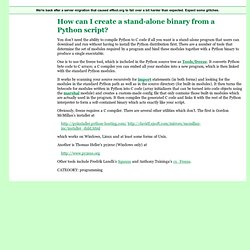
There are a number of tools that determine the set of modules required by a program and bind these modules together with a Python binary to produce a single executable. One is to use the freeze tool, which is included in the Python source tree as Tools/freeze. Oop - What is a metaclass in Python. Understanding Python's "with" statement. Fredrik Lundh | October 2006 | Originally posted to online.effbot.org Judging from comp.lang.python and other forums, Python 2.5’s new with statement (dead link) seems to be a bit confusing even for experienced Python programmers.
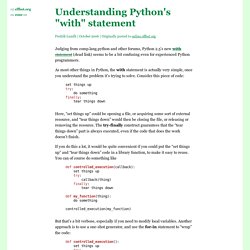
As most other things in Python, the with statement is actually very simple, once you understand the problem it’s trying to solve. Consider this piece of code: set things up try: do something finally: tear things down Here, “set things up” could be opening a file, or acquiring some sort of external resource, and “tear things down” would then be closing the file, or releasing or removing the resource. If you do this a lot, it would be quite convenient if you could put the “set things up” and “tear things down” code in a library function, to make it easy to reuse.
The Python "with" Statement by Example. Python’s with statement was first introduced five years ago, in Python 2.5.

It’s handy when you have two related operations which you’d like to execute as a pair, with a block of code in between. The classic example is opening a file, manipulating the file, then closing it: with open('output.txt', 'w') as f: f.write('Hi there! ') The above with statement will automatically close the file after the nested block of code. (Continue reading to see exactly how the close occurs.) Here’s another example. A life of coding: Closures in Python. Functional programming - Can you explain closures (as they relate to Python) Python Tutorial: decorators (functions and classes) - 2013. Decorators.

(Python) Decorators. Decorators in Python are bit confusing concept to understand.

It is not a standard feature generally explained in many of the Beginners’ books on Python. But, understanding the basic idea of decorators will help us in making a very good use of it. As the rule always goes, there are certain situations where decorators are highly useful but not always. Decorators is a way of transforming functions and methods at the point where the code is declared. The point of transformation is placed just before the method’s own declaration. To give a more clear idea, we generally put some code within a function, make use of it in other functions by calling it, performing some calculations or processing within the function’s body, and finally return some result or print some output. Think of a situation where the attributes of the function get modified when the function is actually executed. Charming Python: Decorators make magic easy.
Doing a lot by doing very little Decorators have something in common with previous metaprogramming abstractions introduced to Python: they do not actually do anything you could not do without them.
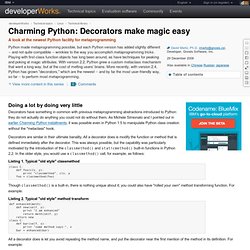
As Michele Simionato and I pointed out in earlier Charming Python installments, it was possible even in Python 1.5 to manipulate Python class creation without the "metaclass" hook. Decorators are similar in their ultimate banality. All a decorator does is modify the function or method that is defined immediately after the decorator. This was always possible, but the capability was particularly motivated by the introduction of the classmethod() and staticmethod() built-in functions in Python 2.2. Listing 1. Class C: def foo(cls, y): print "classmethod", cls, y foo = classmethod(foo) Though classmethod() is a built-in, there is nothing unique about it; you could also have "rolled your own" method transforming function. Listing 2. Python 2.4 Decorators — www.drdobbs. Python3 Tutorial: Memoization and Decorators. Definition of Memoization The term "memoization" was introduced by Donald Michie in the year 1968.
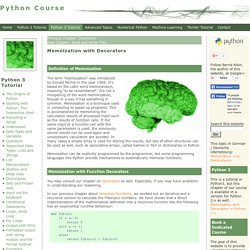
It's based on the Latin word memorandum, meaning "to be remembered". It's not a misspelling of the word memorization, though in a way it has something in common. Memoisation is a technique used in computing to speed up programs. This is accomplished by memorizing the calculation results of processed input such as the results of function calls.
Memoization can be explicitly programmed by the programmer, but some programming languages like Python provide mechanisms to automatically memoize functions. DecoratorLibrary. This page is meant to be a central repository of decorator code pieces, whether useful or not <wink>.

It is NOT a page to discuss decorator syntax! Feel free to add your suggestions. Please make sure example code conforms with PEP 8. Creating Well-Behaved Decorators / "Decorator decorator" Note: This is only one recipe. Toggle line numbers 1 def simple_decorator(decorator): 2 '''This decorator can be used to turn simple functions 3 into well-behaved decorators, so long as the decorators 4 are fairly simple. Functional Programming HOWTO — Python v2.7.5 documentation. In this document, we’ll take a tour of Python’s features suitable for implementing programs in a functional style.
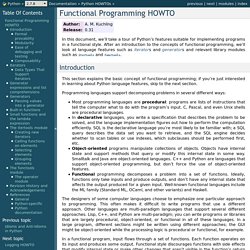
After an introduction to the concepts of functional programming, we’ll look at language features such as iterators and generators and relevant library modules such as itertools and functools. Introduction This section explains the basic concept of functional programming; if you’re just interested in learning about Python language features, skip to the next section. Programming languages support decomposing problems in several different ways: Most programming languages are procedural: programs are lists of instructions that tell the computer what to do with the program’s input.
The designers of some computer languages choose to emphasize one particular approach to programming. Charming Python: Functional programming in Python, Part 1. Charming Python Making more out of your favorite scripting language David MertzPublished on March 01, 2001 We'd better start with the hardest question: "What is functional programming (FP), anyway?
" One answer would be to say that FP is what you do when you program in languages like Lisp, Scheme, Haskell, ML, OCAML, Clean, Mercury, or Erlang (or a few others). That is a safe answer, but not one that clarifies very much. Python Conquers The Universe. There are a lot of tutorials[1] for Python’s lambda out there. A very helpful one is Mike Driscoll’s discussion of lambda on the Mouse vs Python blog. Mike’s discussion is excellent: clear, straight-forward, with useful illustrative examples. It helped me — finally — to grok lambda, and led me to write yet another lambda tutorial. Lambda is a tool for building functions, or more precisely, for building function objects. Functional Programming with Python. By Alexey Kachayev, 2012 About me Position: CTO at Kitapps Inc. Production experience: Python, Java, JS, Go, Scala, Clojure, Erlang Looked at: Haskell, Lisp, Scheme.
Tail Recursion Elimination. I recently posted an entry in my Python History blog on the origins of Python's functional features. A side remark about not supporting tail recursion elimination (TRE) immediately sparked several comments about what a pity it is that Python doesn't do this, including links to recent blog entries by others trying to "prove" that TRE can be added to Python easily. So let me defend my position (which is that I don't want TRE in the language). If you want a short answer, it's simply unpythonic. Here's the long answer: First, as one commenter remarked, TRE is incompatible with nice stack traces: when a tail recursion is eliminated, there's no stack frame left to use to print a traceback when something goes wrong later. Second, the idea that TRE is merely an optimization, which each Python implementation can choose to implement or not, is wrong.
Advanced Python or Understanding Python. How to Speed up a Python Program 114,000 times. High Performance Python I. Code Like a Pythonista: Idiomatic Python. In this interactive tutorial, we'll cover many essential Python idioms and techniques in depth, adding immediately useful tools to your belt. There are 3 versions of this presentation: ©2006-2008, licensed under a Creative Commons Attribution/Share-Alike (BY-SA) license.
My credentials: I am a resident of Montreal,father of two great kids, husband of one special woman,a full-time Python programmer,author of the Docutils project and reStructuredText,an editor of the Python Enhancement Proposals (or PEPs),an organizer of PyCon 2007, and chair of PyCon 2008,a member of the Python Software Foundation,a Director of the Foundation for the past year, and its Secretary. In the tutorial I presented at PyCon 2006 (called Text & Data Processing), I was surprised at the reaction to some techniques I used that I had thought were common knowledge. Many of you will have seen some of these techniques and idioms before.
These are the guiding principles of Python, but are open to interpretation. Python programming idioms. November 2007 Summary. A few things to remember while coding in Python. Hidden features of Python. (How to Write a (Lisp) Interpreter (in Python)) Syntax and Semantics of the Lispy Scheme Subset The syntax of a language is what it looks like; the semantics is what it means.
For example, in the language of mathematical expressions, the syntax for adding two plus two is "2 + 2" and the semantics of that expression is the number four. We say we are evaluating a syntactic expression when we determine its semantic referent; we would say that "2 + 2" evaluates to 4, and write that as "2 + 2" ⇒ 4. Most computer languages have a variety of syntactic conventions (keywords, infix operators, brackets, operator precedence, dot notation, semicolons, etc.), but as a member of the Lisp family of languages, all of Scheme's syntax is based on lists in parenthesized prefix notation. This may seem unfamiliar, but it has the virtues of simplicity and consistency. Learning Python Programming Language Through Video Lectures. PyCon 2010:The Mighty Dictionary (#55) Pycon 2010 atlanta presents the mighty dictionary (#55) by brandon craig rhodes video produced by carl karsten & a team in conjunction with the psf and support from: [sauce ___ ijwbitz you too can support the psf:
Python - Advanced List Sorting. Consider a list of tuples. We could get such a list when processing information that was extracted from a spreadsheet program. For example, if we had a spreadsheet with raw census data, we can easily transform it into a sequence of tuples that look like the following. jobData= [ (001,'Albany','NY',162692), (003,'Allegany','NY',11986), ... (121,'Wyoming','NY',8722), (123,'Yates','NY',5094) ] Each tuple can be built from a row of the spreadsheet.
Python: copying a list the right way. How to use *args and **kwargs in Python. Operators and String Formatting in Python. Although not actually modulus, the Python % operator works similarly in string formatting to interpolate variables into a formatting string. If you've programmed in C, you'll notice that % is much like C's printf(), sprintf(), and fprintf() functions. There are two forms of %, one of which works with strings and tuples, the other with dictionaries. StringOperand % TupleOperand StringOperand % DictionaryOperand. Advanced String Formatting. PEP Index> PEP 3101 -- Advanced String Formatting Abstract. Doctest – Testing through documentation. Doctest lets you test your code by running examples embedded in the documentation and verifying that they produce the expected results. Generator Tricks for Systems Programmers. __slots__ in Python: Save some space and prevent member variable additions.